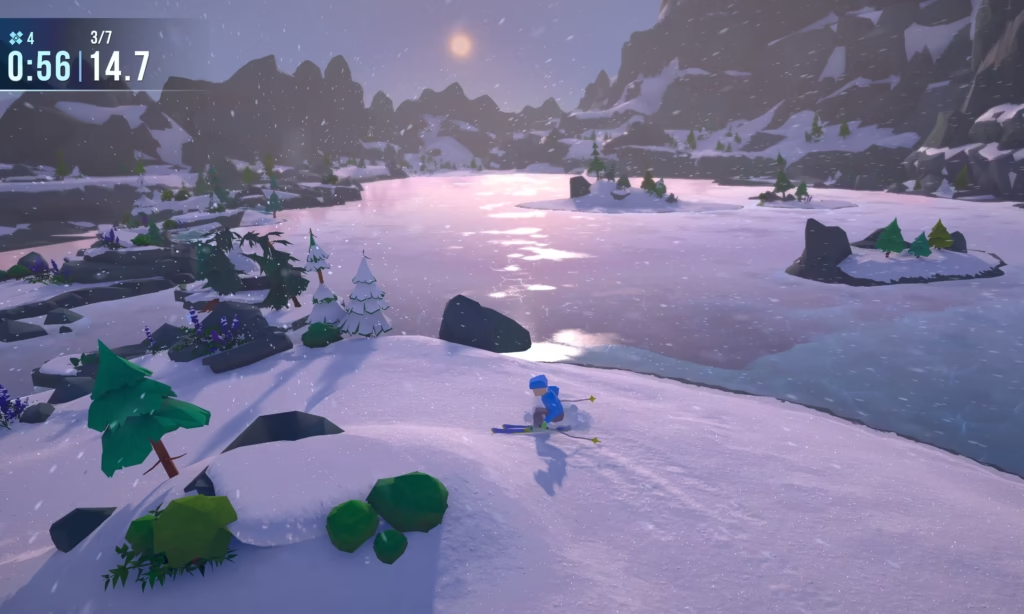
There was a time when nearly anyone with a home console owned a snowboarding game. In the late 1990s and early 2000s, critical and commercial successes like 1080 Snowboarding (1998), SSX Tricky (2001), and SSX (2003) dominated the market and spawned a dozen not-so-acclaimed knock-offs. Then, somewhere in the mid-2000s, these winter sports games fell out of favour; they disappeared.
So what happened? One likely reason is that these games were extraordinarily same-y. Games that attempted to replicate the success of SSX usually felt derivative. They copied not just the series’ arcadey gameplay but its aesthetic and humour, too: and, by the late 2000s, the bombastic, hyperactive, maximalist vibe was just not doing it anymore. Even more recent attempts to renew the genre, such as Rider’s Republic (2021), hold an echo of this feeling. As a result, even in 2025 there is a remarkable – and disappointing – dearth of games in this genre.
What the genre needs, then, is exploration and experimentation – and this is where Lonely Mountains: Snow Riders (2025) stands out. Quite the opposite of SSX’s gaudy silliness, Lonely Mountains is a slow, no-frills game – it’s your character and your skis, and you have to get to the bottom of a big snowy hill without falling off. That’s it. No power-ups, no boost, no insane tricks with crazy multiplier bonuses.
Make no mistake, though, this is not an easy game. This is tricky, risk-reward gameplay, where a slight misinput is the difference between gliding carelessly past a tree at 60kmh or faceplanting directly into it. Mastery over player movement is everything. And gratefully, the movement is excellently weighted and extremely responsive. You can feel the changes in friction as you glide over differing depths of snow; you must balance speed and control on a second-to-second basis. This can be punishing, but still remains forgiving enough to produce some exhilarating holy-shit-I-cant-believe-I-got-away-with-that moments. Rarely do you crash and think it wasn’t your fault – the promise of control is always there, even if you can’t quite grasp it yet.
The game’s presentation is also excellent. Trails are calm and quiet. There’s no music, just the ambient sounds of the mountain and your skis swishing through the snow. The art direction is beautiful, too – the mountains glitter in the sun, and snow whips gently in the wind. It’s like you’re playing a game inside a long-forgotten snowglobe.
These clean aesthetics extend to the game’s philosophy, too. This is a no-bullshit game, with simple, intuitive game-modes, and no commercialized battle-passes, microtransactions, et cetera – even though it would’ve been easy enough to shoehorn these into the game’s multiplayer. The result of this is a friendly and charming multiplayer experience, where players of all skill levels are cheered for simply crossing the finish line, and where competition arises organically – not from level markers or skill-based matchmaking. Stumbling upon someone roughly of your skill level often leads to tense one-on-one races where you push each other to your limits in friendly rivalry – it reminds me of the multiplayer days of yore, before rampant commercialization.
There is one sticking point that may put off some people, however: the camera. Instead of opting for a simple over-the-shoulder perspective, the game uses a static camera that shifts to different predetermined positions as you move through the track. This is intended, I imagine, as an additional challenge in the game: when the camera is behind you, the goal is speed; but when it’s in front of you and you can’t see what’s coming next, it’s a game of momentum and anticipation.
This adds to the game’s novelty, for sure, but the effect isn’t always great: the constant shifting occasionally feels like you’re watching your character from the perspective of an indecisive drone, and at high speeds, it almost gave me motion sickness. After a few dozen hours with the game, I ‘get’ the camera and what it’s aiming to do – but I still can’t help but wonder if the game would be more satisfying if it just remained still. This is one of those things that is purely personal taste – some will be turned off the game on account of it, and some will love it for its unique challenge.
Nevertheless, Lonely Mountains succeeds not just because it is an excellently realized, beautifully-made game: it succeeds because it innovates and advances a fading genre. By inverting the lurid, high-octane style of most winter sports games and injecting it with a contemporary focus on mechanical challenge, the game poses the question: what more could this genre be with some daring experimentation? For this reason, Lonely Mountains deserves a place as one of the best and most exciting games in its category.
